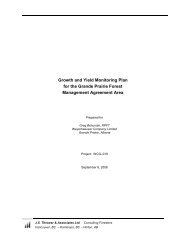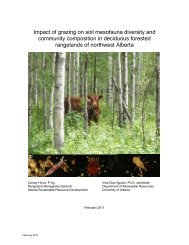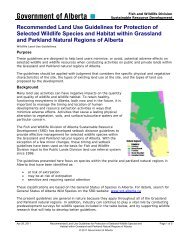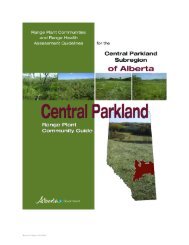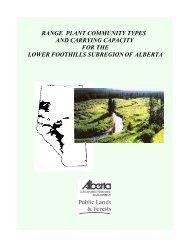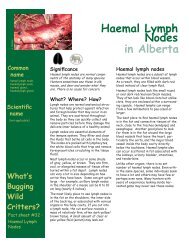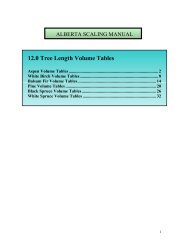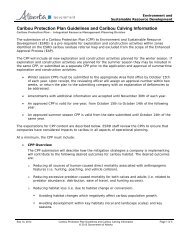Foothills Fescue Range Plant Community Guide - Sustainable ...
Foothills Fescue Range Plant Community Guide - Sustainable ...
Foothills Fescue Range Plant Community Guide - Sustainable ...
You also want an ePaper? Increase the reach of your titles
YUMPU automatically turns print PDFs into web optimized ePapers that Google loves.
5.0 Classification Methods<br />
5.1 <strong>Plant</strong> <strong>Community</strong> Classification Methods<br />
Data for this analysis consisted mostly of range survey and rangeland reference area data<br />
collected by Alberta <strong>Sustainable</strong> Resource Development from 1986 until present. A total<br />
of 487 vegetation inventory forms were analyzed. All data records were reviewed for<br />
completeness, species seven letter codes were assigned along with a unique identifier<br />
number for each transect. The data were then entered into the Prairie Data Base<br />
(<strong>Range</strong>land Management Branch, Alberta <strong>Sustainable</strong> Resource Development). The data<br />
base calculates mean values for species composition, total vegetation, moss/lichen and<br />
bare soil cover.<br />
The results of vegetation transect queries were extracted from the Prairie Data Base and<br />
formatted for analysis in a two dimensional matrix in the *.wk1 format that PC-ORD<br />
requires. Ordination and classification studies were carried out on the data sets using PC-<br />
ORD (MJM Software, Gleneden Beach, Oregon). The corresponding land data including<br />
soils and site information were sorted into a corresponding land data matrix.<br />
In order to establish major plant community types, ordination and classification<br />
interpretations were developed by using two statistical procedures (Willoughby 1997):<br />
a) De-trended Correspondence Analysis was applied (Gauch 1982). This procedure<br />
compares similarity and dissimilarity among sites. Plotting of the ordination scores in<br />
three dimensional “species space” allows viewing of site and species distributions and<br />
facilitates grouping of sites by community types.<br />
b) A cluster analysis procedure was employed as an alternate grouping technique to<br />
compare and contrast with the results of the DCA procedure. Ward’s method of cluster<br />
analysis was the most easily interpreted from the six or more procedures that might be<br />
chosen.<br />
<strong>Plant</strong> community type summaries were generated in Quattro 9 by averaging plant species<br />
composition, range in composition and percent constancy of occurrence among groups of<br />
vegetation inventory plots considered to form a unique plant community type.<br />
Environmental data were subsequently sorted into the same plant community groups as<br />
described above for further analysis and correlation with plant community groupings.<br />
Total vegetation canopy cover, moss/lichen and bare soil estimates were also calculated<br />
for the plant community type groupings of vegetation inventory plots. The resulting plant<br />
community descriptions are reported in one page summaries similar to those used by<br />
Willoughby et al. (2003).<br />
Ecologically sustainable stocking rates (ESSR) values are suggested for each plant<br />
community. These values reflect the maximum number of livestock (e.g.Animal Unit<br />
Months (AUM)/acre) that can be supported by the plant community given inherent<br />
biophysical constraints and the ecological goal of sustainable health and proper<br />
functioning of the plant community. When the ESSR is multiplied by the area (e.g. acres)<br />
of a plant community polygon the result is termed ecologically sustainable carrying<br />
capacity (ESCC), and is expressed as AUMs. At times, the ESCC must be adjusted for<br />
management factors (e.g. reduced livestock distribution), management goals (e.g.<br />
improve rangeland health, multiple use and values, etc.), drought conditions, and other<br />
natural phenomena impacting the site (e.g. forage quality, fire, pests, etc.). This<br />
25



